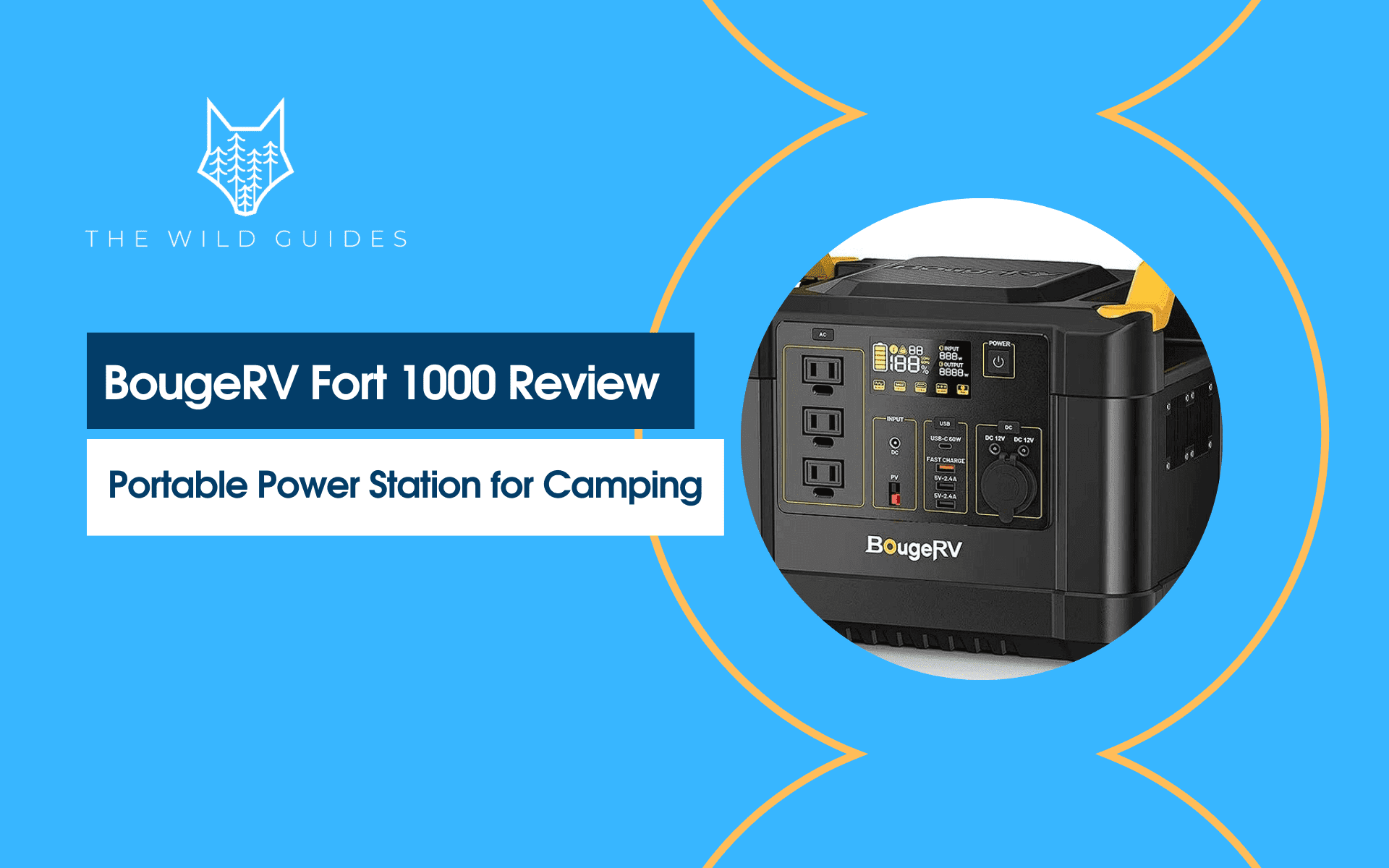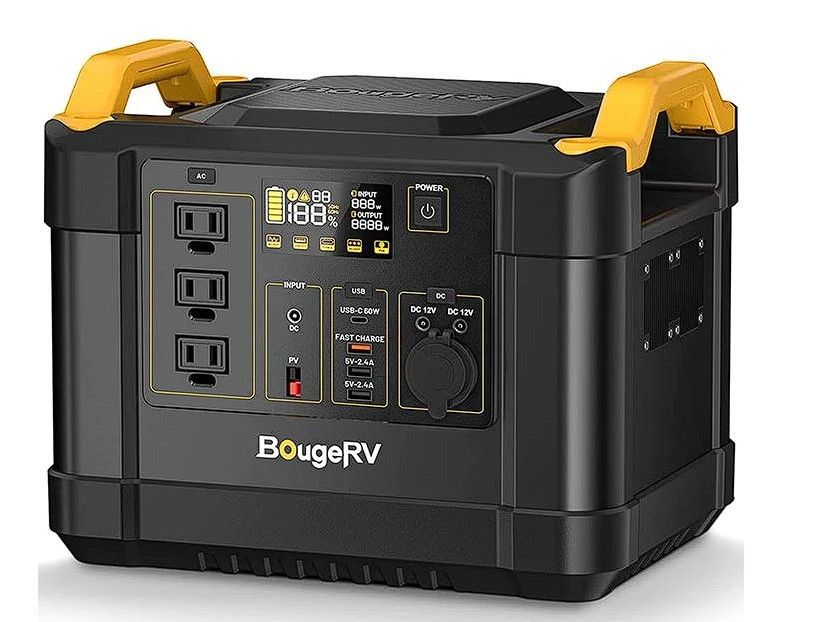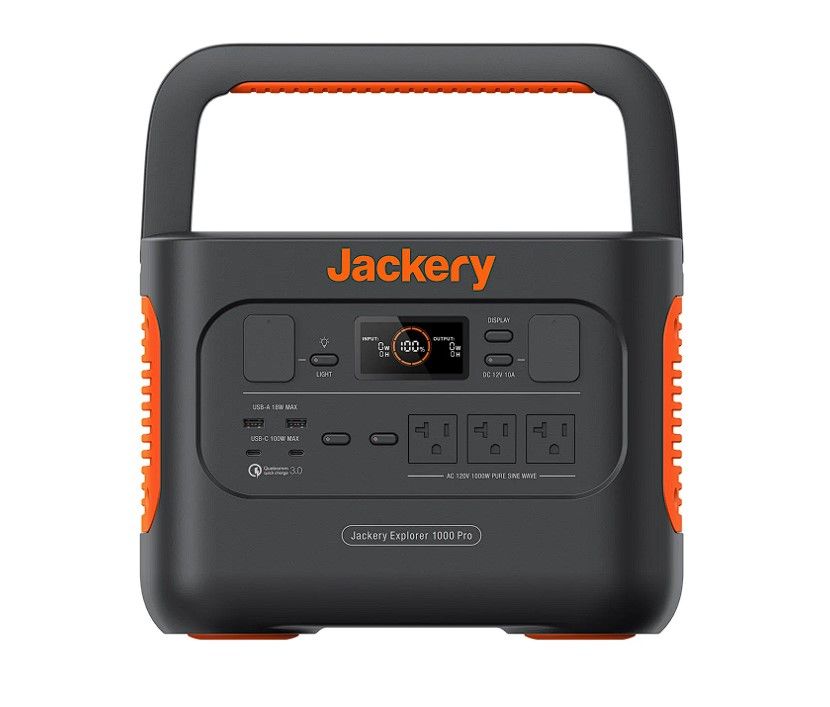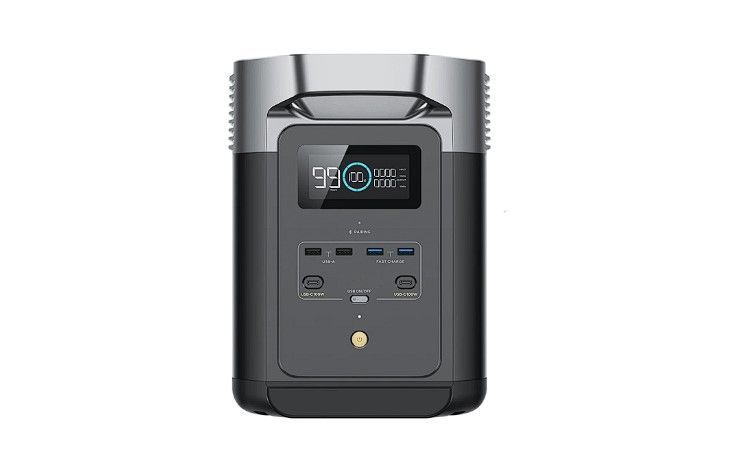BougeRV Fort 1000 Power Station Review: My Go-To Camping Piece This Summer

This BougeRV Fort 1000 power station review will tell you everything you need to know about this affordably-priced portable battery, including the power of its inverter, recharging options, and output ports. I’ll also reveal how much time its battery takes to go from 0 to 100%.
Having taken this unit on a few front country camping trips, I’ll also compare it with the Jackery Explorer 1000 Pro, Goal Zero Yeti 1000X and EcoFlow Delta 2 power station I had the chance to use. So that you have other options on hand if you feel the Fort 1000 can’t meet your requirements.
Quick Summary
The BougeRV Fort 1000 1120Wh LiFeP04 portable power station is easy to carry, offers 10 output ports, and has a user-friendly LED display showing remaining battery life, error codes, and more. Plus, it lets you charge its battery over 3,500+ times, almost 7x as much as its competitors.
Having carried this unit everywhere in my SUV, I can attest that it’s super-compact. That is because it took little to no space in my vehicle’s boot. Also, even after carrying it between two tent sites on a reasonably large campground, I have to say that it felt pretty light and fairly easy to carry.
This shows that this model is great for simple camping trips where you might need some extra power.

BougeRV Fort 1000 Ratings
- 4.9⭐ on BougeRV
- 4.5⭐ on Amazon
BougeRV Coupon Codes
- Use the code TWG200 to get $200 Off the Fort 1000
- Use the code TWG16 to get 16% off on any BougeRV product
BougeRV Fort 1000 Review
Package Contents
Here’s what I found on opening the BougeRV Fort 1000 box:
- BougeRV Fort 1000 Pro
- Car charging cable
- AC charger
- Solar Charging Cable (MC4 to Anderson)
- User Manual
These items allowed me to start using this unit straight away. However, I’m yet to purchase the solar panels that BougeRV sells separately.

Weight and Build
The BougeRV Fort 1000 weighs 28.7bs (13 kg). This makes this model notably lighter than its colleague I previously used, the Fort 1500 power station. However, while the Fort 1500 does weigh 11 pounds more, it is equally compact and takes up as little space in my SUV’s trunk.
A backlit LED display adorns the user-facing side of this power station. Not only is the display easy to read, but it also serves highly useful info. I was able to read the remaining battery power, current charging status and input/output power without having to focus too hard.
Most other power stations I have tested have separate on/off buttons for each port. That is also the case with this model. Each section of the ports (USB, AC, DC, etc.) on this BougeRV power station has a button that you need to click. This is an excellent feature, as it saved me from accidentally draining the battery.

BougeRV Fort 1000 Ratings
- 4.9⭐ on BougeRV
- 4.5⭐ on Amazon
BougeRV Coupon Codes
- Use the code TWG200 to get $200 Off the Fort 1000
- Use the code TWG16 to get 16% off on any BougeRV product
Battery and Ports
The BougeRV Fort 1000 power station packs a reasonably powerful 1120Wh, Lithium Iron Phosphate (LiFePO4) battery. If BougeRV is to be believed, the battery will retain up to 80% of its capacity for the first 3,500 life cycles. As you’ll see in the coming sections, if this is true, this is a massive advantage over rivals.
Befitting a power station that costs a grand, it has a battery management system (BMS) protecting its battery from all sorts of unwanted incidents. These include over-charging, over-current, under-current, and more. As such, you don’t have to worry about the battery’s health.
Turning our attention to ports, and the Fort 1000 has plenty of them. This unit comes with 3x AC ports, 1x USB-C port, 2x USB-A ports, and 1x USB-A QC 3.0 port. A 1x DC car port is also on offer, though I’d have liked this unit more if it had come with an extra USB-C port for my gadgets.
Given the fact that its built-in inverter sends out pure sine wave current, sensitive electronic items such as smartphones, laptops, and tablets are safe with this unit. I have repeatedly used this model to charge my Pixel Pro 7 and the battery health is yet to drop by 1%, a sign of a safe power supply.

Recharging Options
You have multiple options to recharge the Fort 1000, including:
- 2000W wall outlet – 4.5 hours
- USB-C PD 60W – 4.5 hours
- BougeRV Solar Panel – 4.5 to 5 hours under full sunlight
When I first received this model, I immediately plugged it in to see whether the above claim was true. Guess what? It took less time (almost 4 hours) for its battery to go from 0% to 100%.

BougeRV Fort 1000 Ratings
- 4.9⭐ on BougeRV
- 4.5⭐ on Amazon
BougeRV Coupon Codes
- Use the code TWG200 to get $200 Off the Fort 1000
- Use the code TWG16 to get 16% off on any BougeRV product
Other Notable Features
Here are other neat features of the BougeRV Fort 1000:
- Built-in MPPT charge controller. A built-in MPPT controller provides this unit with several benefits, the most notable of which is faster recharging time, especially when this model is drawing power from compatible solar panels.
- Incredibly long battery lifecycle. In contrast to rival models from Jackery and Goal Zero (which claim to retain 80% of battery capacity for the first 500 charging cycles), this model’s battery can retain the same capacity for 3,500 cycles.
- Excellent ventilation system. Despite using this device to juice up devices big and small, I cannot recall a single scenario where it got too hot to the touch. The credit for this goes to the ventilation silos on both sides of this model.
- Displays error codes. Although this unit is yet to misbehave, the knowledge that it will display the error code on display (which I can easily decipher using the info given in the user’s manual) gives me a lot of peace of mind.

Pros and Cons
The BougeRV Fort 1000 power station checks various boxes for outdoor enthusiasts like myself. This model is incredibly easy to carry, can juice up several devices at the same time, and can be recharged using solar panels. A long battery life and excellent heat dissipation system further sweeten the deal.
However, there are shortcomings which may put some customers off. For instance, its 12-month warranty appears lackluster when compared with similar models from other brands. However, to be fair, those models cost more than the Fort 1000 and have batteries that last less.

BougeRV Fort 1000 Ratings
- 4.9⭐ on BougeRV
- 4.5⭐ on Amazon
BougeRV Coupon Codes
- Use the code TWG200 to get $200 Off the Fort 1000
- Use the code TWG16 to get 16% off on any BougeRV product
Let’s look at the pros and cons of BougeRV Fort 1000:
BougeRV Fort 1000 Pros
- Incredibly long battery lifecycle
- Bright, user-friendly LED display
- Offers 10 output ports
- Built-in BMS
BougeRV Fort 1000 Cons
- Relatively short warranty compared to its competition
Best Solar Panel for BougeRV Fort 1000
The BougeRV 130W Mono Portable Solar Panel is undoubtedly the best for Fort 1000. BougeRV claims that this solar panel can take the Fort 1000’s battery from 0 to 100% charging within 4.5 hours, provided you place the panel in an area where it’s getting direct sunlight.
Having not had the chance to put the above claim to the test, I cannot verify or deny it. What I can do, however, is tell you that the other claims BougeRV made (especially the one about a 200W wall outlet fully recharging the battery within 4.5 hours) are true.
So, I’d like to think that BougeRV isn’t bluffing with the solar recharging claim. But if you want to be fully sure, you’d have to test the claim for yourself.
How It Compares With Other Portable Power Stations
BougeRV Fort 1000 Vs. Jackery Explorer 1000 Pro

Jackery Explorer 1000 Pro
- Power: 1002 Wh
- Weight: 25.4 lbs.
- Dimensions: 13.4″ x 10.3″ x 10.1″
- Ratings: 5.0⭐ out of 48 reviews on Jackery
- Similarities: The Fort 1000 and Explorer 1000 Pro have the same number of AC ports (3) and the same surge capacity (2000W).
- Where the BougeRV Fort 1000 Pro fares better: Despite costing $100 less ($999 vs. $1,099), the Fort 1000 Pro’s battery can last up to nine times longer (3,500 lifecycles at 80% capacity vs. 500 lifecycles) and is slightly more powerful (1120Wh vs. 1,002Wh).
- Where the Explorer 1000 Pro fares better: This portable power station weighs less (22 lbs vs. 28.7 lbs) and offers more USB-C ports (2 vs. 1) than the BougeRV 1000. It also comes with a bigger warranty (2+1 years vs. 1 year).
BougeRV Fort 1000 Vs. Goal Zero Yeti 1000X

Goal Zero Yeti 1000X
- Power: 983 Wh
- Weight: 31.7 lbs.
- Dimensions: 15.25″ x 10.23″ x 9.86″
- Ratings: 4.2⭐ out of 27 reviews on REI
- Similarities: Both these portable power stations come with a built-in BMS and can be quickly recharged via solar panels thanks to integrated MPPT controllers.
- Where the BougeRV Fort 1000 Pro fares better: This device comes weighs less than the Yeti 1000X (27lbs vs. 31.68lbs), has a more powerful battery (1120Wh vs. 983Wh) and offers an extra AC port (3 vs. 2). And with all that it costs $300 less than the Yeti 1000X.
- Where the Yeti 1000X fares better: While both units’ inverters output pure sine wave current, the Yeti 1000X’s boasts a higher surge capacity (3000W vs. 2000W). Also, this unit comes with a higher warranty (2 years vs. 1 year).
BougeRV Fort 1000 Vs. EcoFlow Delta 2

EcoFlow Delta 2
- Power: 1024 Wh
- Weight: 27 lbs.
- Dimensions: 15.7″ x 8.3″ x 11″
- Ratings: 4.7⭐ out of 613 reviews on Amazon
- Similarities: Both units come with lithium-ion phosphate batteries that can last for over 3,000 lifecycles while retaining up to 80% battery capacity (to be more precise, the Fort 1000 offers 3,500 lifecycles and the Delta 2 offers 3,000). Both power stations also cost the same (at this moment it’s $999) and weigh almost the same.
- Where the BougeRV Fort 1000 fares better: Although both units weigh almost the same, the Fort 1000 is notably more compact. This makes this model less of a hassle to carry around than the (relatively) bulky EcoFlow Delta 2. The Fort 1000 also has a slightly more powerful capacity (1,120Wh vs 1,024Wh).
- Where the EcoFlow Delta 2 fares better: This portable power station offers more AC outlets (6 vs. 3), USB-C ports (2 vs. 1), and a higher surge capacity (2,700W vs. 2,000W). Plus, you can charge it in just 2 hours using compatible solar panels. Delta 2 also offers a whopping 5 year warranty compared to BougeRV’s 1 year.
BougeRV Fort 1000 Vs. Fort 1500

Given that both models come from the same manufacturer, one can expect various similarities. However, having used and tested Fort 1000 and 1500, I can tell you from personal experience that there are more differences between these models than what meets the eye.
Areas Where Fort 1000 Fares Better
One of the major areas where the Fort 1000 fares better is weight. This model weighs much less (28.7 lbs vs. 35 pounds) than the Fort 1500. Also, in addition to being lighter of the two, it’s also much more compact. Small wonder, then, that it doesn’t occupy much space in my SUV’s boot.
Additionally, while it outputs less power than the Fort 1500, this model also costs $500 less, making it a must-have for budget-minded shoppers.
Areas Where Fort 1500 Fares Better
The recently-released Fort 1500 gives you multiple reasons to prefer it over its colleague. The first of which is a 5-year warranty, which, in theory, means that this model should last four years extra. Surely, the added lifespan can justify the $500 extra in price, right?
A higher continuous output and surge capacity mean you can count on this device to juice up power-hungry devices, which is something you cannot say about the Fort 1000. Plus, with an SOS light, this model came in handy for me when it was pitch dark on my campsites.
If you ask me, which of the two power stations to get, I would probably say it depends on what you need from it. To me, someone who enjoys camping and being in outdoors, the Forst 1000 is more than enough to power up all of my gadgets. But for someone who relies more on juiced-up technology and gadgets or who enjoys staying longer in the outdoors than I usually do, the Fort 1500 is probably a better option.
For more details, you can check my BougeRV Fort 1500 review.

BougeRV Fort 1000 Ratings
- 4.9⭐ on BougeRV
- 4.5⭐ on Amazon
BougeRV Coupon Codes
- Use the code TWG200 to get $200 Off the Fort 1000
- Use the code TWG16 to get 16% off on any BougeRV product

Frequently Asked Questions
How long does BougeRV Fort 1000 last?
The Fort 1000’s battery is rated to last up to 3,500 cycles while retaining up to 80% of its capacity. Put another way, this model should last between 8 to 10 years, if not longer.
How many solar panels does it take to charge a Fort 1000?
BougeRV claims that one 130W Mono Portable Solar Panel can charge this device from 0 to 100% within 4.5 to 5 hours (under full sunlight).
Can BougeRV Fort 1000 run a microwave?
Absolutely. I lent my Fort 1000 to a camping buddy and asked him to use it as much as possible. On one of his recent front-country RV trips, it kept his 800W microwave running for over an hour.
Can BougeRV Fort 1000 run a TV?
That’s right. Once fully charged, the Fort 1000 can supply power to a 90W TV for up to 10 hours.
Can you run a fridge on the Fort 1000?
As long as it isn’t supplying power to another device, a fully-charged Fort 1000 can keep a mini fridge (60W) running for up to 15 hours. Check out how I chaged the BougeRV 30 quart 12 Volt car refrigerator on my road trip.

BougeRV Fort 1000 Ratings
- 4.9⭐ on BougeRV
- 4.5⭐ on Amazon
BougeRV Coupon Codes
- Use the code TWG200 to get $200 Off the Fort 1000
- Use the code TWG16 to get 16% off on any BougeRV product
BougeRV Fort 1000 Video Review
Take a look at the BougeRV Fort 1000 on my Youtube video, and a full review will be uploaded soon.
Portable power station guides
Use this table to find out all the reviews I made about the best portable power stations in the industry.
